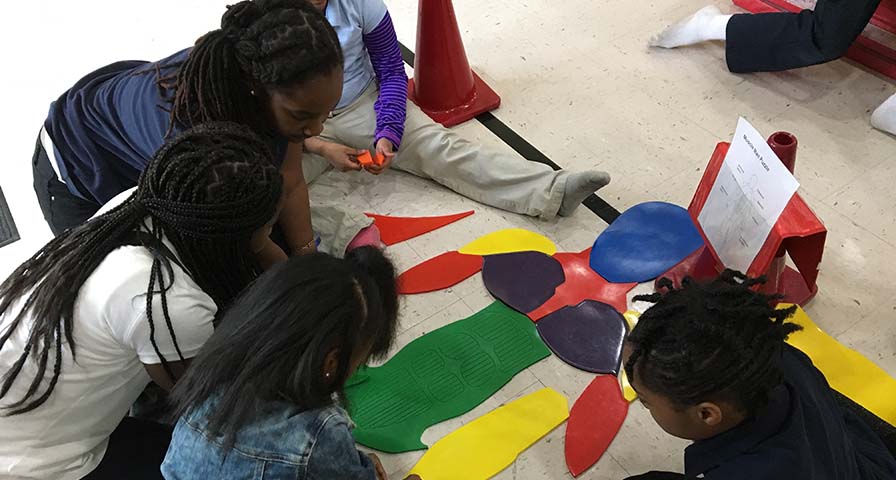Teacher Uses Technology to Encourage Students to Exercise at Elevated Heart Rates to Build Essential Healthy Habits
By giving his students an early introduction to PE heart rate monitors, David Kober wants to nurture their passion for activity and develop heart rate training skills that will help students lead healthy lifestyles.
“Our community isn’t always as active and healthy as it needs to be,” Kober said. “I want to teach the students how to be healthy and why it’s important to be healthy. As they get older, this is just something they need to know to stay healthy.”
Kober joined the faculty at Dr. Katie Harper Wright Elementary School (East St. Louis, Ill.) in 2014 tasked with building the school’s first PE program. Kober initially added pedometers to his program but quickly looked for technology that proved more meaningful.
“We had pedometers before, but I don’t feel like counting steps tells you anything,” he said. “Your heart rate tells you how your blood is flowing, tells you if you’re having to work hard. All of that tells you what kind of shape your body is in. That’s why I like the heart rate monitors.”
He didn’t have heart rate monitors or the budget to buy them. But in April, 2017, Kober discovered IHT’s Spirit Video Challenge, which offered a class set of 28 IHT ZONE PE heart rate monitors along with IHT Spirit System® assessment software, to the teacher who submitted the best two-minute video showing how students were proving the value of their PE program. Kober’s video won, and he had his K-4 students using the PE heart rate monitors at the beginning of the 2017-18 school year.
“We jumped right in,” he said.
Adjusting to PE Heart Rate Monitors
The Wright Elementary students enjoy their physical education classes and having new PE heart rate monitors increased their enjoyment and motivation. Early in the year, Kober kept his expectations – and goals for students – simple. He wanted students to:
- Spend part of each class exercising at a moderate level, indicated by yellow on the ZONE heart rate monitor;
- Spend part of each class exercising at a vigorous level, indicated by red on the ZONE HRM; and
- Maintain that effort for a set period of time
Kober uses the students’ excitement about wearing the monitors to help him maximize class time. With only 30 minutes with the students, he encourages them to get organized quickly so they can get more time to exercise wearing the ZONES. He said students get an average of 20 minutes each class to exercise wearing the heart rate monitors.
“Having the monitors really stepped up that excitement a little bit,” Kober said. “They were anxious to get them and wanted to get them as soon as they got into class, so I was able to use that to help with my classroom management.”
As students became more and more comfortable, he added goals to each workout. Depending on the lesson, he challenged students to spend a minimum amount of time exercising in the target heart rate zone. The IHT ZONE PE heart rate monitors showed students if they reached the target zone, and they saw if they’d exercised in the zone long enough on Kober’s computer at the end of class.
“It stepped things up a little more,” he said. “They were excited whenever they (picked up the ZONE). They started looking for how many minutes they needed to hit their goal. Then, when they (returned the ZONE), they could see their graphs and the minutes that they exercised in the target zones and whether they made it or not.”
Utilizing Student Motivation to Teach Health Management Skills
Kober’s students regularly met their goals, which didn’t surprise the teacher given the students’ general excitement about PE. His curriculum mixes relay games with other activities students enjoy such as worksheets with exercise tasks to complete. Kober said his students give the greatest effort when completing worksheets filled with different tasks, which gives him an opportunity to reinforce what they learn in academic classrooms as well.
“They love relay-type stuff, and the worksheets are a favorite of mine because it gets them reading and writing and gets them doing multiple subjects while they are accomplishing their exercise tasks,” he said. “They like to take on the tasks and work toward accomplishing those things.”
In his second year, Kober wants to focus on this 3rd and 4th-grade students, making sure they remain excited about using the PE heart rate monitors. He wants them to develop a solid foundation of fitness skills. He prioritizes these grades because it may be his last chance to instill healthy habits.
“When they get to middle school or high school, depending on whether they like PE or not, sometimes they don’t take PE,” he said. “That’s why it’s so important now to teach them the importance of it, to get them motivated to be healthy so when they get to middle and high school, they will want to continue on. Ultimately, we want them learning lifetime fitness activities. We are trying to show them all of the benefits now.”
Kober’s 2018-19 curriculum, particularly for the 3rd and 4th graders, will focus on the importance of being healthy and teaching students how they can build healthy habits. The curriculum starts with exercising at health-enhancing levels.
“This is an early step to learning about lifelong fitness,” he said. “When they get older, they’ll have the knowledge and skills to keep track of their health and keep themselves healthy.”
Seeking IHT Spirit System information?


